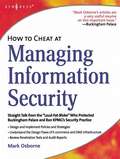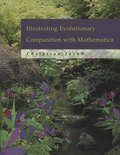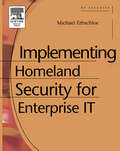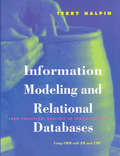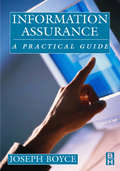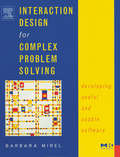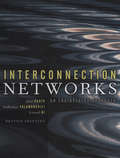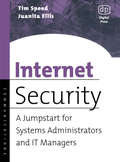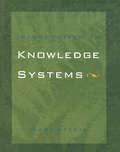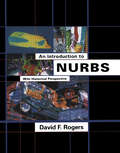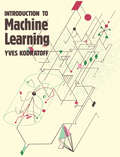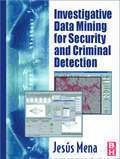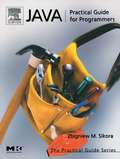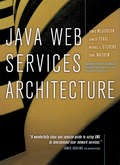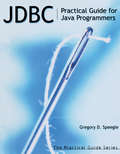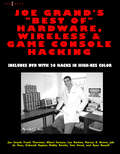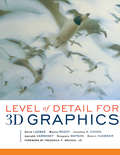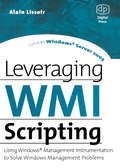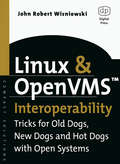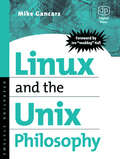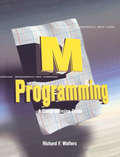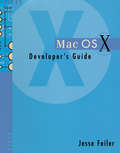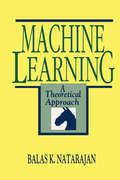- Table View
- List View
How to Cheat at Managing Information Security (How to Cheat)
by Mark OsborneThis is the only book that covers all the topics that any budding security manager needs to know! This book is written for managers responsible for IT/Security departments from mall office environments up to enterprise networks. These individuals do not need to know about every last bit and byte, but they need to have a solid understanding of all major, IT security issues to effectively manage their departments. This book is designed to cover both the basic concepts of security, non – technical principle and practices of security and provides basic information about the technical details of many of the products - real products, not just theory. Written by a well known Chief Information Security Officer, this book gives the information security manager all the working knowledge needed to: • Design the organization chart of his new security organization • Design and implement policies and strategies • Navigate his way through jargon filled meetings • Understand the design flaws of his E-commerce and DMZ infrastructure* A clearly defined guide to designing the organization chart of a new security organization and how to implement policies and strategies* Navigate through jargon filled meetings with this handy aid* Provides information on understanding the design flaws of E-commerce and DMZ infrastructure
Illustrating Evolutionary Computation with Mathematica (The Morgan Kaufmann Series in Artificial Intelligence)
by Christian JacobAn essential capacity of intelligence is the ability to learn. An artificially intelligent system that could learn would not have to be programmed for every eventuality; it could adapt to its changing environment and conditions just as biological systems do. Illustrating Evolutionary Computation with Mathematica introduces evolutionary computation to the technically savvy reader who wishes to explore this fascinating and increasingly important field. Unique among books on evolutionary computation, the book also explores the application of evolution to developmental processes in nature, such as the growth processes in cells and plants. If you are a newcomer to the evolutionary computation field, an engineer, a programmer, or even a biologist wanting to learn how to model the evolution and coevolution of plants, this book will provide you with a visually rich and engaging account of this complex subject.* Introduces the major mechanisms of biological evolution.* Demonstrates many fascinating aspects of evolution in nature with simple, yet illustrative examples.* Explains each of the major branches of evolutionary computation: genetic algorithms, genetic programming, evolutionary programming, and evolution strategies.* Demonstrates the programming of computers by evolutionary principles using Evolvica, a genetic programming system designed by the author.* Shows in detail how to evolve developmental programs modeled by cellular automata and Lindenmayer systems.* Provides Mathematica notebooks on the Web that include all the programs in the book and supporting animations, movies, and graphics.
Implementing Homeland Security for Enterprise IT
by Michael ErbschloeThis book shows what IT in organizations need to accomplish to implement The National Strategy for the Physical Protection of Critical Infrastructures and Key Assets and The National Strategy to Secure Cyberspace which were developed by the Department of Homeland Security after the terrorist attacks of September 2001. The September 11, 2001, attacks illustrated the immense vulnerability to terrorist threats. Since then there have been considerable efforts to develop plans and methods to protect critical infrastructures and key assets. The government at all levels, private sector organizations, as well as concerned citizens have begun to establish partnerships and to develop action plans. But there are many questions yet to be answered about what organizations should actual do to protect their assets and their people while participating in national efforts to improve security. This book provides practical steps that IT managers in all organizations and sectors can take to move security from the planning process into practice.*A one-minute manager approach to issuesp provides background and explanations in all areas*Step-by-step instructions on how to accomplish objectives guide readers through processes*Easy to implement advice allows readers to take quick action
Information Modeling and Relational Databases: From Conceptual Analysis to Logical Design (The Morgan Kaufmann Series in Data Management Systems)
by Terry HalpinInformation Modeling and Relational Databases provides an introduction to ORM (Object Role Modeling)-and much more. In fact, it's the only book to go beyond introductory coverage and provide all of the in-depth instruction you need to transform knowledge from domain experts into a sound database design. Inside, ORM authority Terry Halpin blends conceptual information with practical instruction that will let you begin using ORM effectively as soon as possible. Supported by examples, exercises, and useful background information, his step-by-step approach teaches you to develop a natural-language-based ORM model and then, where needed, abstract ER and UML models from it. This book will quickly make you proficient in the modeling technique that is proving vital to the development of accurate and efficient databases that best meet real business objectives.The most in-depth coverage of Object Role Modeling available anywhere-written by a pioneer in the development of ORM.Provides additional coverage of Entity Relationship (ER) modeling and the Unified Modeling Language-all from an ORM perspective.Intended for anyone with a stake in the accuracy and efficacy of databases: systems analysts, information modelers, database designers and administrators, instructors, managers, and programmers.Explains and illustrates required concepts from mathematics and set theory.
Information Assurance: Managing Organizational IT Security Risks
by Joseph Boyce Daniel JenningsWritten by two INFOSEC experts, this book provides a systematic and practical approach for establishing, managing and operating a comprehensive Information Assurance program. It is designed to provide ISSO managers, security managers, and INFOSEC professionals with an understanding of the essential issues required to develop and apply a targeted information security posture to both public and private corporations and government run agencies.There is a growing concern among all corporations and within the security industry to come up with new approaches to measure an organization's information security risks and posture. Information Assurance explains and defines the theories and processes that will help a company protect its proprietary information including: * The need to assess the current level of risk.* The need to determine what can impact the risk.* The need to determine how risk can be reduced. The authors lay out a detailed strategy for defining information security, establishing IA goals, providing training for security awareness, and conducting airtight incident response to system compromise. Such topics as defense in depth, configuration management, IA legal issues, and the importance of establishing an IT baseline are covered in-depth from an organizational and managerial decision-making perspective.Experience-based theory provided in a logical and comprehensive manner.Management focused coverage includes establishing an IT security posture, implementing organizational awareness and training, and understanding the dynamics of new technologies.Numerous real-world examples provide a baseline for assessment and comparison.
Interaction Design for Complex Problem Solving: Developing Useful and Usable Software (Interactive Technologies)
by Barbara MirelSoftware for complex problem solving can dazzle people with advanced features and alluring visuals, but when actually put to use it often disappoints and even frustrates users. This software rarely follows the user's own work methods, nor does it give people the degree of control and choice that they truly need.This book presents a groundbreaking approach to interaction design for complex problem solving applications. The author uses her vast field experience to present a new way of looking at the whole process, and treats complex problem solving software and web applications as a distinct class with its own set of usefulness demands and design criteria. This approach highlights integrated interactions rather than discrete actions, clearly defines what makes problem solving complex, and explores strategies for analyzing, modeling, and designing for exploratory inquiries.·In depth case studies ranging from IT troubleshooting to marketing analysis to risk assessments in healthcare show exactly where and what goes wrong in real world activities and how to improve them.·Presents a system and framework for analyzing complex work and takes the mystery out of eliciting patterns of work and their meanings.·Offers new perspectives for support and new design strategies for building the right models into programs so that they effectively address users' dynamic work. ·Allows designers to turn findings into useful designs for problems that require users to create new knowledge but with no one right answer and with many methods of reaching solutions.
Interconnection Networks (ISSN)
by Jose Duato Sudhakar Yalamanchili Lionel NiThe performance of most digital systems today is limited by their communication or interconnection, not by their logic or memory. As designers strive to make more efficient use of scarce interconnection bandwidth, interconnection networks are emerging as a nearly universal solution to the system-level communication problems for modern digital systems. Interconnection networks have become pervasive in their traditional application as processor-memory and processor-processor interconnect. Point-to-point interconnection networks have replaced buses in an ever widening range of applications that include on-chip interconnect, switches and routers, and I/O systems. In this book, the authors present in a structured way the basic underlying concepts of most interconnection networks and provide representative solutions that have been implemented in the industry or proposed in the research literature.* Gives a coherent, comprehensive treatment of the entire field* Presents a formal statement of the basic concepts, alternative design choices, and design trade-offs* Provides thorough classifications, clear descriptions, accurate definitions, and unified views to structure the knowledge on interconnection networks* Focuses on issues critical to designers
Internet Security: A Jumpstart for Systems Administrators and IT Managers
by Tim Speed Juanita EllisInternet Security incorporates not only the technology needed to support a solid security strategy but also those policies and processes that must be incorporated in order for that strategy to work.New methods of breaking into corporate networks are resulting in major losses. This book provides the latest information on how to guard against attacks and informs the IT manager of the products that can detect and prevent break-ins. Crucial concepts such as authentication and encryption are explained, enabling the reader to understand when and where these technologies will be useful. Due to the authors' experiences in helping corporations develop secure networks, they are able to include the newest methods for protecting corporate data.· Shield data from both the internal and external intruder· Discover products that can detect and prevent these break-ins · Protect against major losses with the latest incident handling procedures for detecting and recovering data from new viruses· Get details of a full security business review from performing the security risk analysis to justifying security expenditures based on your company's business needs
Introduction to Knowledge Systems
by Mark StefikFocusing on fundamental scientific and engineering issues, this book communicates the principles of building and using knowledge systems from the conceptual standpoint as well as the practical. Previous treatments of knowledge systems have focused on applications within a particular field, or on symbol-level representations, such as the use of frame and rule representations. Introduction to Knowledge Systems presents fundamentals of symbol-level representations including representations for time, space, uncertainty, and vagueness. It also compares the knowledge-level organizations for three common knowledge-intensive tasks: classification, configuration, and diagnosis. The art of building knowledge systems incorporates computer science theory, programming practice, and psychology. The scope of this book is appropriately broad, ranging from the design of hierarchical search algorithms to techniques for acquiring the task-specific knowledge needed for successful applications. Each chapter proceeds from concepts to applications, and closes with a brief tour of current research topics and open issues. Readers will come away with a solid foundation that will enable them to create real-world knowledge systems using whatever tools and programming languages are most current and appropriate.
An Introduction to NURBS: With Historical Perspective (The Morgan Kaufmann Series in Computer Graphics)
by David F. RogersThe latest from a computer graphics pioneer, An Introduction to NURBS is the ideal resource for anyone seeking a theoretical and practical understanding of these very important curves and surfaces. Beginning with Bézier curves, the book develops a lucid explanation of NURBS curves, then does the same for surfaces, consistently stressing important shape design properties and the capabilities of each curve and surface type. Throughout, it relies heavily on illustrations and fully worked examples that will help you grasp key NURBS concepts and deftly apply them in your work. Supplementing the lucid, point-by-point instructions are illuminating accounts of the history of NURBS, written by some of its most prominent figures. Whether you write your own code or simply want deeper insight into how your computer graphics application works, An Introduction to NURBS will enhance and extend your knowledge to a degree unmatched by any other resource.Presents vital information with applications in many different areas: CAD, scientific visualization, animation, computer games, and more.Facilitates accessiblity to anyone with a knowledge of first-year undergraduate mathematics.Details specific NURBS-based techniques, including making cusps with B-spline curves and conic sections with rational B-spline curves.Presents all important algorithms in easy-to-read pseudocode-useful for both implementing them and understanding how they work.Includes complete references to additional NURBS resources.
Introduction to Machine Learning
by Yves KodratoffA textbook suitable for undergraduate courses in machine learningand related topics, this book provides a broad survey of the field.Generous exercises and examples give students a firm grasp of theconcepts and techniques of this rapidly developing, challenging subject.Introduction to Machine Learning synthesizes and clarifiesthe work of leading researchers, much of which is otherwise availableonly in undigested technical reports, journals, and conference proceedings.Beginning with an overview suitable for undergraduate readers, Kodratoffestablishes a theoretical basis for machine learning and describesits technical concepts and major application areas. Relevant logicprogramming examples are given in Prolog.Introduction to Machine Learning is an accessible and originalintroduction to a significant research area.
Investigative Data Mining for Security and Criminal Detection
by Jesus MenaInvestigative Data Mining for Security and Criminal Detection is the first book to outline how data mining technologies can be used to combat crime in the 21st century. It introduces security managers, law enforcement investigators, counter-intelligence agents, fraud specialists, and information security analysts to the latest data mining techniques and shows how they can be used as investigative tools. Readers will learn how to search public and private databases and networks to flag potential security threats and root out criminal activities even before they occur. The groundbreaking book reviews the latest data mining technologies including intelligent agents, link analysis, text mining, decision trees, self-organizing maps, machine learning, and neural networks. Using clear, understandable language, it explains the application of these technologies in such areas as computer and network security, fraud prevention, law enforcement, and national defense. International case studies throughout the book further illustrate how these technologies can be used to aid in crime prevention.Investigative Data Mining for Security and Criminal Detection will also serve as an indispensable resource for software developers and vendors as they design new products for the law enforcement and intelligence communities.Key Features: * Covers cutting-edge data mining technologies available to use in evidence gathering and collection * Includes numerous case studies, diagrams, and screen captures to illustrate real-world applications of data mining * Easy-to-read format illustrates current and future data mining uses in preventative law enforcement, criminal profiling, counter-terrorist initiatives, and forensic science* Introduces cutting-edge technologies in evidence gathering and collection, using clear non-technical language* Illustrates current and future applications of data mining tools in preventative law enforcement, homeland security, and other areas of crime detection and prevention* Shows how to construct predictive models for detecting criminal activity and for behavioral profiling of perpetrators* Features numerous Web links, vendor resources, case studies, and screen captures illustrating the use of artificial intelligence (AI) technologies
Java: Practical Guide for Programmers (The Practical Guides)
by Michael SikoraIf you're an experienced programmer, you already have a rock-solid foundation for learning Java. All you need is a resource that takes your experience into account and explains Java's key principles and techniques in an intelligent, efficient way. Java: Practical Guide for Programmers is precisely that resource. Here, you won't have to wade through hundreds of pages of overly simplistic material to learn the basics of Java programming. Instead, you get highly focused instruction in the core elements of Java 1.4, accompanied by carefully chosen examples and line-by-line analyses that are right to the point. You'll be astonished at how soon you can begin productive coding in Java, and how quickly your skills will progress.Written expressly for people who already know a procedural or object-oriented programming language. Takes a concise approach designed to make the most of the experience you already have. Covers the core elements of Java 1.4, including language syntax, OO features, collections, exception handling, input/output, threads, event handling, and Swing components. Filled with incisive coding examples and line-by-line analyses.
Java Web Services Architecture (The Morgan Kaufmann Series in Data Management Systems)
by Michael Stevens Sunil Mathew James McGovern Sameer TyagiWritten by industry thought leaders, Java Web Services Architecture is a no-nonsense guide to web services technologies including SOAP, WSDL, UDDI and the JAX APIs. This book is useful for systems architects and provides many of the practical considerations for implementing web services including authorization, encryption, transactions and the future of Web Services.Covers all the standards, the JAX APIs, transactions, security, and more.
JDBC: Practical Guide for Java Programmers (The Practical Guides)
by Gregory D. SpeegleJDBC: Practical Guide for Java Programmers is the quickest way to gain the skills required for connecting your Java application to a SQL database. Practical, tutorial-based coverage keeps you focused on the essential tasks and techniques, and incisive explanations cement your understanding of the API features you'll use again and again. No other resource presents so concisely or so effectively the exact material you need to get up and running with JDBC right away.Provides tutorial-based instruction in key JDBC techniques, complemented by example code.Centered around an incrementally developed example of a three-tiered application for a video rental e-commerce site.Designed to help you tackle standard JDBC tasks: connecting your database to the Internet, displaying query results, using stored procedures, updating the database, storing metadata, carrying out transactions, working with binary large objects, implementing security, and more.
Jim Blinn's Corner: Notation, Notation, Notation (The Morgan Kaufmann Series in Computer Graphics)
by Jim BlinnThe third entry in the Jim Blinn's Corner series, this is, like the others, a handy compilation of selected installments of his influential column. But here, for the first time, you get the "Director's Cut" of the articles: revised, expanded, and enhanced versions of the originals. What's changed? Improved mathematical notation, more diagrams, new solutions. What remains the same? All the things you've come to rely on: straight answers, irreverent style, and innovative thinking. This is Jim Blinn at his best - now even better.Features 21 expanded and updated installments of "Jim Blinn's Corner," dating from 1995 to 2001, and never before published in book formIncludes "deleted scenes"—tangential explorations that didn't make it into the original columnsDetails how Blinn represented planets in his famous JPL flyby animationsExplores a wide variety of other topics, from the concrete to the theoretical: assembly language optimization for parallel processors, exotic usage of C++ template instantiation, algebraic geometry, a graphical notation for tensor contraction, and his hopes for a future world
Joe Grand's Best of Hardware, Wireless, and Game Console Hacking
by Joe Grand Frank Thornton Albert Yarusso Lee Barken Tom Owad Ryan Russell Bobby Kinstle Marcus R Brown Job de Haas Deborah KaplanThe book introduces the principles of hardware design and describes the tools and techniques required to begin hacking. The DVD contains hack instructions for over 20 game consoles and hardware devices from Nintendo, Apple, Sony, Microsoft, Palm and more.The presentation of these 20 projects on DVD media provides users with benefits and options not available on the printed page. All images are hi-res color that can be enlarged or printed, the text is easily searched, and the user can copy the contents to their hard disk and add comments directly into the PDF files. The DVD media also lends itself well to group projects (it includes a 10 user license).The 160-page book includes chapters on hacking tools and electrical engineering basics, along with chapters on the background, design and functionality of each hardware device.* Packed full of high resolution colour images that reveal the smallest details of each step in a hack* Includes in depth coverage of the tools of the hacking trade and the basics of electrical engineering* DVD includes a "Using the Tools" video starring Joe "kingpin" Grand
Level of Detail for 3D Graphics (The Morgan Kaufmann Series in Computer Graphics)
by David Luebke Martin Reddy Jonathan D. Cohen Amitabh Varshney Benjamin Watson Robert HuebnerLevel of detail (LOD) techniques are increasingly used by professional real-time developers to strike the balance between breathtaking virtual worlds and smooth, flowing animation. Level of Detail for 3D Graphics brings together, for the first time, the mechanisms, principles, practices, and theory needed by every graphics developer seeking to apply LOD methods.Continuing advances in level of detail management have brought this powerful technology to the forefront of 3D graphics optimization research. This book, written by the very researchers and developers who have built LOD technology, is both a state-of-the-art chronicle of LOD advances and a practical sourcebook, which will enable graphics developers from all disciplines to apply these formidable techniques to their own work.* Is a complete, practical resource for programmers wishing to incorporate LOD technology into their own systems.* Is an important reference for professionals in game development, computer animation, information visualization, real-time graphics and simulation, data capture and preview, CAD display, and virtual worlds.* Is accessible to anyone familiar with the essentials of computer science and interactive computer graphics.* Covers the full range of LOD methods from mesh simplification to error metrics, as well as advanced issues of human perception, temporal detail, and visual fidelity measurement.* Includes an accompanying Web site rich in supplementary material including source code, tools, 3D models, public domain software, documentation, LOD updates, and more. Visit http://LODBook.com.
Leveraging WMI Scripting: Using Windows Management Instrumentation to Solve Windows Management Problems (HP Technologies)
by Alain LissoirLeveraging WMI Scripting is the second in a series of two books dedicated to WMI. Understanding WMI Scripting (ISBN 1-55558-266-4), Lissoir's first book, explained to Windows Administrators the various WMI scripting techniques and manageability capabilities of this new Windows Server 2003 platform. Illustrated with hundreds of scripts and detailed tables, the book explained the underlying technology and how WMI can be put to work. Lissoir focused not only on WMI programming aspects for developers but on how administrators can use what is available in Windows for their admin work. If you've had significant WMI experience, or have read Lissoir's first book, you are ready to apply your WMI knowledge to any technology that interfaces with WMI. Leveraging WMI Scripting continues the presentation of WMI begun in Understanding WMI Scripting. In this new volume, we dive deeper into WMI to understand the manageable entities of the Windows world. Lissoir offers a structured description of the most important WMI providers available from Windows NT 4.0 to Windows Server 2003 (including Windows 2000 and Windows XP). This covers the WMI management of the Windows Registry, Active Directory, SNMP, the Resultant Set Of Policies (RSOP), and the Volume Shadow Service to name a few. This discussion leverages the information on building real-world scripted management solutions presented in Lissoir's first book. Like the first volume, Leveraging WMI Scripting is based on an important concept: "learning by practice." Leveraging WMI Scripting addresses the most advanced topics so that you can exploit the features of various WMI interfaces to manage the components in a real-world environment. WMI is a critical topic under Windows Server 2003, so this book provides real added value to every Windows administrator.· Shows you how to extract data from applications, understand what's really happening on your servers, and get real work done · Provides hundreds of usable scripts to use in everyday solutions for network performance and security· Offers practical and straightforward advice that any enterprise Windows administrator can learn from
Lexical Ambiguity Resolution: Perspective from Psycholinguistics, Neuropsychology and Artificial Intelligence
by Garrison W. Cottrell Steven L. Small Michael K. TanenhausThe most frequently used words in English are highly ambiguous; for example, Webster's Ninth New Collegiate Dictionary lists 94 meanings for the word "run" as a verb alone. Yet people rarely notice this ambiguity. Solving this puzzle has commanded the efforts of cognitive scientists for many years. The solution most often identified is "context": we use the context of utterance to determine the proper meanings of words and sentences. The problem then becomes specifying the nature of context and how it interacts with the rest of an understanding system. The difficulty becomes especially apparent in the attempt to write a computer program to understand natural language. Lexical ambiguity resolution (LAR), then, is one of the central problems in natural language and computational semantics research.A collection of the best research on LAR available, this volume offers eighteen original papers by leading scientists. Part I, Computer Models, describes nine attempts to discover the processes necessary for disambiguation by implementing programs to do the job. Part II, Empirical Studies, goes into the laboratory setting to examine the nature of the human disambiguation mechanism and the structure of ambiguity itself.A primary goal of this volume is to propose a cognitive science perspective arising out of the conjunction of work and approaches from neuropsychology, psycholinguistics, and artificial intelligence--thereby encouraging a closer cooperation and collaboration among these fields.Lexical Ambiguity Resolution is a valuable and accessible source book for students and cognitive scientists in AI, psycholinguistics, neuropsychology, or theoretical linguistics.
Linux and OpenVMS Interoperability: Tricks for Old Dogs, New Dogs and Hot Dogs with Open Systems (HP Technologies)
by John Robert WisniewskiMake OpenVMS High Availability systems and low cost Open System computers work together in complex Intranet and Internet environments.Users of Linux, UNIX and the hundreds of thousands of OpenVMS installations world-wide will find invaluable information in Linux and OpenVMS Interoperability. This book gives you access to the best resources of both Linux and OpenVMS systems by providing practical hints, tricks, and step-by-step processes for installing and interoperating both systems. If you've heard one of John Wisniewski's many presentations on the subject, you'll find that he also brings his expertise and his own brand of humor to the task of explaining these operating systems to new and experienced programmers and administrators.· Covers the capabilities, features, and advantages of both Linux and OpenVMS· Offers tested solutions to practical interoperability problems · Provides a basis for you to choose the right operating system for your needs
Linux and the Unix Philosophy
by Mike GancarzUnlike so many books that focus on how to use Linux, Linux and the Unix Philosophy explores the "way of thinking that is Linux" and why Linux is a superior implementation of this highly capable operating system.This book is a revision and expansion of a computer science classic. Every chapter has been thoroughly updated with Linux coverage.Linux and the Unix Philosophy falls squarely between the "softer" texts on iterative software design and project management and the "how-to" technical texts. Thus far, no one has come out with a book that addresses this topic, either in the Unix space or the Linux space. Linux and the Unix Philosophy covers the same ground as the first edition, while it also presents bold new ideas about Linux and Open Source.· Concise list of philosophy tenets makes it a handy quick reference· Anecdotal examples personalize the book for the reader· Conversational style makes it easy and joyful to read
M Programming: A Comprehensive Guide
by Richard WaltersM Programming: A Comprehensive Guide is a complete update to ABCs of MUMPS. While ABCs of MUMPS was an introduction for novice and intermediate M programmers, M Programming: A Comprehensive Guide has a new section containing advanced material. This new section addresses features such as transaction processing, networking, structured system variables, and interfaces to other standards. Five new chapters have been added, covering an overview of M for readers familiar with other languages; M and the Windows environment; interaction between M and the underlying system; transaction processing; interfacing M with other standards; and error handling. Sections on interactive programming and futures have been extensively updated. M Programming: A Comprehensive Guide is an invaluable resource for everyone who is learning or using M.· Includes section on advanced programming· Completely updated for the 1995 standard
Mac OSX Developer's Guide
by Jesse FeilerMac OS X, Apple's newest operating system for the Macintosh platform, is profoundly different from its earlier versions because of its similarity to the UNIX operating system. For developers writing software for OS X this means adjusting to two new environments to create applications and to access the enhanced features of the new OS, Cocoa and Carbon. Cocoa is an object-oriented API in which all future OS X programs will be written. Carbon is a transitional technology allowing compatibility of applications written for earlier versions of the Mac OS with Mac OS X.Mac OS X Developer's Guide focuses equally on Cocoa and Carbon, guiding the reader through these technologies and showing how to write applications in both. It is the first book for Mac OS X developers written for those who are already working on applications, as well as new developers just getting started. It starts off describing the new OS and its development tools then focuses on specific programming issues, providing tips on making the transition from classic Mac OS code to Mac OS X. * A guide for developers already writing applications as well as new developers just getting started* Focuses equally on both Cocoa and Carbon environments* Provides tips on transitioning from writing code for classic Mac OS to OS X* References Apple online materials extensively, to keep developers up to speed on changes
Machine Learning: A Theoretical Approach
by Balas K. NatarajanThis is the first comprehensive introduction to computational learning theory. The author's uniform presentation of fundamental results and their applications offers AI researchers a theoretical perspective on the problems they study. The book presents tools for the analysis of probabilistic models of learning, tools that crisply classify what is and is not efficiently learnable. After a general introduction to Valiant's PAC paradigm and the important notion of the Vapnik-Chervonenkis dimension, the author explores specific topics such as finite automata and neural networks. The presentation is intended for a broad audience--the author's ability to motivate and pace discussions for beginners has been praised by reviewers. Each chapter contains numerous examples and exercises, as well as a useful summary of important results. An excellent introduction to the area, suitable either for a first course, or as a component in general machine learning and advanced AI courses. Also an important reference for AI researchers.
